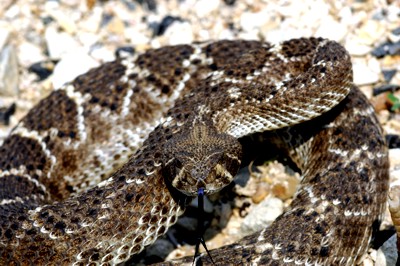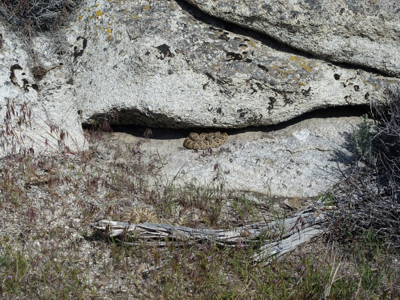![]()
![]()
 |
When Trekking out in the desert it is always a good idea to know what kind of snakes you might expect to see. - you'll see'm. Exploring Black Rock's Caves, Mines or Desert Terrain the most common snake you will run across is the Rattlesnake.
Do you know where rattlesnakes are most commonly found? Do you know what to do if you or someone with you has been bitten by one? This will give you a better understanding about snake safety and what to do if you are ever in close proximity to one.
Generally when exploring Snake Safety means Rattlesnake Safety. Rattlesnakes are the most diverse of all these snakes roaming from Southwestern Canada to Argentina. In the United States they are mostly found in the southern regions, Nevada is considered the Southwest. When we are Trekking around in the desert we always keep a ear out for a rattlesnake nearby. Before we enter a mine we always toss a rock in to see if there is an unsuspecting snake. Snakes want to get out of the hot desert heat just like you, and they will find nice cool shady spots. So next time you want to cool down under a tree, or in a mine, do yourself a favor and check to see if the spot is already occupied. Same goes for Scorpions - they'll get ya.
First things first, don’t ever provoke a snake. If it’s not bothering you, don’t bother it. We believe in keeping our snake karma up and the best way to do that is be respectful to our slithery friends.
Over the years we have run into our fair share of snakes and have never had a problem with them, but that doesn’t mean we shouldn’t be prepared to deal with an angry rattler.
 |
Snakes are great at hiding. Click on image for a surprise. |
Rattlesnakes will hide in mines to get away from the hot sun. They also occasionally fall down a mine shaft and will get stranded at the bottom. A herd of baby Rattlesnakes are just as bad as a big one, and you will find babys in cool caves and mines.
If you are ever bitten by a venomous snake or struck by a Scorpion, the best thing you can do is seek medical help ASAP. Minimize movement if possible, this means no running in panic, split or sling the bitten area and remove any restricting clothing around the bite. Apply firm pressure to the bite or a pressure bandage, be sure to make a note of any inflammation by tracing the bite mark with a pen. This will help medical examiners treat your wound. Stay calm and don’t raise your injured body part above your head. Remember most bites can be treated successfully within the first few hours.
Be sure to NOT take any pain relievers or aspirin. No tourniquets or snake bite kits, as these are ineffective and outdated. Do not wash the infected area, traces of venom left on the skin/bandages from the snake can be used to identify the snake. This speeds determines which anti-venom to administer.
The most important thing to remember about snakes, or any animal, is they are afraid of you as much as you are afraid of them. Keep an eye/ear out for them and keep your distance. There is no reason why you both can’t enjoy the desert together.
Oh yes; Scorpions don't make sounds.
